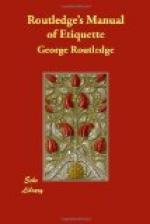[Illustration]
SMALL BIRDS.
Fieldfares, larks, corn-crakes, quails, plovers, and ruffs and reeves, should be always cut through the breast, and served only for two helps.
HARE.
[Illustration]
The old way of carving a hare, still insisted on at many economical tables, is somewhat elaborate. You must first insert the knife in the point of the shoulder marked 1, and divide it down along the line to the rump, 2; and doing the same at the opposite side, the hare falls into three pieces. Pass the knife under the shoulder, 2—1, and remove it; then the leg, which is really good, in a similar manner. The animal must be beheaded, for it is necessary to divide the head, which must be done by turning the mouth towards you, holding it steadily down with the fork, inserting the knife through the bone between the ears, and forcing it through, entirely dividing it. Half the head is given to any one that requires it, the crisp ears being first cut off, a delicacy some prefer. The back, which is the most tender part, must now be divided through the spine into several pieces; it is only after the back is distributed that it is necessary to have recourse to the shoulders and legs. If the hare be old, it is useless to attempt to carve it entirely at table, the joints become so stubborn with age; and it is then usual to cut long slices on each side of the back-bone. A great deal of the blood usually settles in the shoulders and back of the neck, giving the flesh a richness which epicures like; and these parts, called the sportsman’s pieces, are sometimes demanded. The seasoning or stuffing of a hare lies inside, and must be drawn out with a spoon.
RABBIT.
The rules for carving a hare sufficiently direct the mode of carving a rabbit, except that, being so much smaller, the back is never divided into more than two or three pieces, and the head is served whole, if demanded. The wing is thought a choice part by many.
Toasts and Sentiments.
* * * * *
AMATORY.
British belles and British fashions.
Laughing lovers to merry maids.
Love and opportunity.
Love’s slavery.
Love without licentiousness, and pleasure without excess.
Love, liberty, and length of blissful days.
Love without fear, and life without care.
Love for one.
Life, love, liberty, and true friendship.
Love in every breast, liberty
in every heart, and learning in
every head.
Love at liberty, and liberty in love.
Love: may it never make a wise man play the fool.
Artless love and disinterested friendship.




